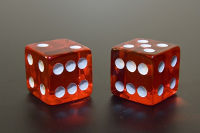Calculating Poker Expected Value
 Expected Value (also known as “Expectation” or simply “EV”) tells you how much money you can expect to win in the long run.
Expected Value (also known as “Expectation” or simply “EV”) tells you how much money you can expect to win in the long run.
The key being “in the long run,” since even if you have positive expectation in poker, you can’t expect to win every single pot. Short-term, your results might indicate completely opposite of what your expected value really is.
Betonline Poker - #1 in the U.S
- Accepts U.S. customers with large player pool
- 10+ years with a strong reputation
- $2,500 deposit bonus
How Much EV Do You Need?
The most important thing to care about is whether your decisions have a positive expectation or not–knowing the exact amount of positive expectation is secondary. If you can play with positive expectation more often than with negative expectation, you’re on the right track.
The next step after identifying positive EV situations is to learn how to compare actions and determine which of the decisions is the most profitable one. Best players concentrate on making the absolute best decision, not just a “good” decision.
Example: Let’s look at rolling a die. Someone offers you $70 in case you roll the chosen number and you’ll have to pay $10 in case you fail at rolling the chosen number. Do you have positive expectation?
The odds of rolling one of the sides of a die are 5:1 since there are six sides overall. Meaning there are five outcomes that lose you money and one outcome that wins you money (the number you’ve chosen). All of these outcomes are equally probable.
Out of six rolls, you’ll lose $10 five times and win $70 once on average. Now you calculate the difference over six rolls ($70-$50=$20) and divide it by 6 ($20:6=$3.333). Therefore your expectation per roll is a little bit over $3. After a million rolls, you should have made close to three million dollars.
How to Calculate Expected Value in Poker
I’m guessing you now have an idea of how to calculate the expected value based on the example above. Let’s look at some poker situations where you can (and should) use poker EV calculations to figure out if you’re going to win in the long run:
Pre-Flop
You’re on the button with QJ-offsuit. A short-stacker from the cut-off goes all-in with 12 big blinds and you’re wondering whether you should call. Let’s say, for the sake of making this example simple, that the blinds behind you fold 100% of the time. For the sake of simplicity, we’ll also assume that you know your opponent’s got AK.
Do you have positive expectation?
There are 13.5 big blinds in the pot (1.5 from the blinds) and you have to call 12 big blinds. In other words, you have a chance of winning 13.5 big blinds by risking 12 big blinds. Your pot odds are 1.125:1. AK wins about 66% of the time against QJ, meaning the odds are 2:1 because QJ wins 33% of the time (66 is twice the size of 33). In this case, pot odds being 1.125:1 and your winning odds being 2:1 (you risk 47% of the pot but win only 33% of the time) you wouldn’t have positive expectation.
It’s all about the relationship between risk and reward.
0.33×13.5bb-0.66x12bb=3.47bb
You risk: 47% of the pot.
Your chances of winning: 33%.
Expectation: -3.47 big blinds
Flop
You have A♥J♥ and the flop is K♣9♥7♥. For the sake of this example being simple, each time you hit your flush draw, you win, and each time you don’t, you lose. There’s $100 in the pot already, and your opponent bets $70, meaning there’s $170 in the pot and $70 for you to call, giving you 2.4:1 pot odds.
You have 9 outs out of 47 cards, meaning the odds of hitting your flush draw are 5.2:1. In other words, you risk 41% of the pot but you win the pot only 19% of the time, so again, you have negative expectation, and this decision wouldn’t be profitable.
The calculation: 0.19x$170-0.81$70=$24.40
You risk: 41% of the pot.
Your chances of winning: 19%.
Expectation: -$24.40
River
It’s a bit easier to calculate the poker expected value on the river than on the other streets since you don’t have to worry about what the opponent does on future streets.
Let’s say there’s $100 in the pot (no need for specific cards this time), your opponent bets $80 and you’ve got a set. Based on your experience with the opponent, here’s how you estimate his hand:
- 10% of the time he’s got two pairs.
- 20% of the time he’s got nothing (bluff).
- 20% of the time he’s got a higher set.
- 20% of the time he’s got a flush.
- 30% of the time he’s got top pair, top kicker.
So you’re going to win 60% of the time.
At this point we calculate the pot odds – there’s $180 in the pot (including the opponent’s bet) and you have to risk $80 by calling, so your pot odds are 2.25:1. Since you risk 44% of the pot and you win the pot 60% of the time, this call would be profitable.
But what is your exact expected value in this situation? Let’s see: you’ll lose $80 (the amount you call) 40% of the time and win $180 (the amount in the pot excluding the amount you call) 60% of the time.
The calculation: 0.6x$180-0.4x$80=$76.
You risk: 44% of the pot.
Your chances of winning: 60%
Expectation: +$76
EV and Pot Equity
Some players seem to confuse poker expected value and pot equity even though there’s an important difference between the two.
For example, say you’re heads-up against a short-stacked opponent and the pot is $100. You know your pot equity to be 40% of the pot (or $40). The opponent now bets his remaining $15 into the pot. Your pot equity is still 40% of the pot (or $46) but what about the expected value of calling?
By calling the bet, you’d win $115 40% of the time and lose $15 60% of the time.
$115*0.40=$46
$15*0.60=$9
$46-$9=$37
The EV of calling is +$37 for you. Calling is profitable even though your pot equity is 40%.
Should You Ever Refuse Positive Expectation?
You should absolutely refuse some situations with positive expectation. For example, if you’ve been offered money for free by three different persons, you don’t just take the one that gives you money… you take the one that gives you the most money. So if you decide to make a decision because it’s +EV, good for you, but it may not be the correct decision in case there’s some other way to get even more expected value.
The same applies to poker: if you can make profit by calling, but even more profit by raising, you should raise even though calling would be +EV too.

